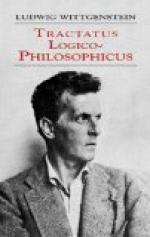4.242 Expressions of the form ‘a = b’ are, therefore, mere representational devices. They state nothing about the meaning of the signs ‘a’ and ‘b’.
4.243 Can we understand two names without knowing whether they signify the same thing or two different things?—Can we understand a proposition in which two names occur without knowing whether their meaning is the same or different? Suppose I know the meaning of an English word and of a German word that means the same: then it is impossible for me to be unaware that they do mean the same; I must be capable of translating each into the other. Expressions like ‘a = a’, and those derived from them, are neither elementary propositions nor is there any other way in which they have sense. (This will become evident later.)
4.25 If an elementary proposition is true, the state of affairs exists: if an elementary proposition is false, the state of affairs does not exist.
4.26 If all true elementary propositions are given, the result is a complete description of the world. The world is completely described by giving all elementary propositions, and adding which of them are true and which false. For n states of affairs, there are possibilities of existence and non-existence. Of these states of affairs any combination can exist and the remainder not exist.
4.28 There correspond to these combinations the same number of possibilities of truth—and falsity—for n elementary propositions.
4.3 Truth-possibilities of elementary propositions mean Possibilities of existence and non-existence of states of affairs.
4.31 We can represent truth-possibilities by schemata of the following kind (’T’ means ‘true’, ‘F’ means ‘false’; the rows of ‘T’s’ and ‘F’s’ under the row of elementary propositions symbolize their truth-possibilities in a way that can easily be understood):
4.4 A proposition is an expression of agreement and disagreement with truth-possibilities of elementary propositions.
4.41 Truth-possibilities of elementary propositions are the conditions of the truth and falsity of propositions.
4.411 It immediately strikes one as probable that the introduction of elementary propositions provides the basis for understanding all other kinds of proposition. Indeed the understanding of general propositions palpably depends on the understanding of elementary propositions.
4.42 For n elementary propositions there are ways in which a proposition can agree and disagree with their truth possibilities.
4.43 We can express agreement with truth-possibilities by correlating the mark ‘T’ (true) with them in the schema. The absence of this mark means disagreement.
4.431 The expression of agreement and disagreement with the truth possibilities of elementary propositions expresses the truth-conditions of a proposition. A proposition is the expression of its truth-conditions. (Thus Frege was quite right to use them as a starting point when he explained the signs of his conceptual notation. But the explanation of the concept of truth that Frege gives is mistaken: if ‘the true’ and ’the false’ were really objects, and were the arguments in Pp etc., then Frege’s method of determining the sense of ‘Pp’ would leave it absolutely undetermined.)




